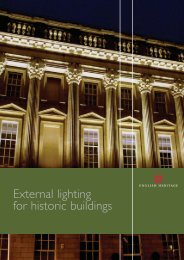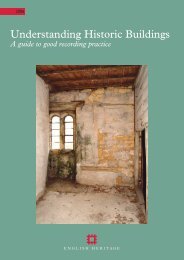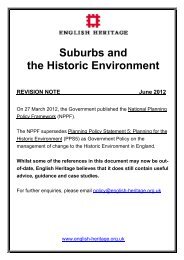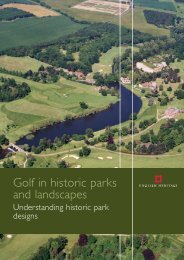You also want an ePaper? Increase the reach of your titles
YUMPU automatically turns print PDFs into web optimized ePapers that Google loves.
<strong>The</strong> <strong>Heritage</strong> <strong>of</strong><br />
Historic <strong>Suburbs</strong>
More than 8 out <strong>of</strong> 10 people in England live in suburban areas 1 . Many <strong>of</strong> these areas are<br />
currently undergoing significant change; in some areas by infilling and intensification <strong>of</strong> uses,<br />
in others through a struggle to regain their former vibrancy.This document, which should<br />
be read in conjunction with the English <strong>Heritage</strong> policy statement <strong>Suburbs</strong> and the Historic<br />
Environment, sets out the history and evolution <strong>of</strong> the English suburb and outlines the context<br />
for the issues currently facing local planning authorities in relation to suburban areas.<br />
In <strong>Suburbs</strong> and the Historic Environment, English <strong>Heritage</strong> sets out how it sees their future<br />
planning and how local authorities can best respond to the challenges they face.<strong>The</strong>se<br />
documents are the first step in our work with partners engaged with suburban planning,<br />
and are designed to help all those involved achieve the best and most sustainable solutions.<br />
<strong>The</strong> planning system is currently undergoing far-reaching<br />
modernisation.This, together with other factors such<br />
as the Sustainable Communities agenda, is influencing<br />
decisions being taken that have significant implications<br />
for historic suburbs. Changes in central planning policy<br />
in recent years to achieve higher density in development<br />
and contribute to sustainability objectives have shifted the<br />
perception <strong>of</strong> suburbia by local planning authorities and<br />
private developers.This has led to an increasing number<br />
<strong>of</strong> problems specific to suburbia, a fuller discussion <strong>of</strong> which<br />
can be found in <strong>Suburbs</strong> and the Historic Environment.<br />
English <strong>Heritage</strong> believes that the most successful<br />
approach to planning, executing and managing change<br />
in our suburbs is one based on a sound understanding<br />
<strong>of</strong> local character, including its integral landscape. We are<br />
continuing to develop our understanding <strong>of</strong> the issues<br />
facing local planning authorities, and further research<br />
\to this end is underway. Collaboration with partner<br />
organisations to analyse suburban issues and possible<br />
solutions forms part <strong>of</strong> our strategy.<br />
WHAT DO WE MEAN BY SUBURB?<br />
<strong>The</strong> English suburb has been the subject <strong>of</strong> much analysis<br />
and many publications, yet a consensus about a precise<br />
definition has never emerged. Recent research projects have<br />
produced several differing typologies <strong>of</strong> suburban areas<br />
In general terms, suburbs can perhaps be best described<br />
as outgrowths or dependencies <strong>of</strong> larger settlements —<br />
somewhere with a clear relationship with a city or town<br />
but with its own distinct character. Most places we think<br />
<strong>of</strong> as urban today were suburban once. Southwark was<br />
a Roman and mediaeval suburb <strong>of</strong> London; Edinburgh s<br />
Front cover — Beckenham, London Borough <strong>of</strong> Bromley.<br />
1 DETR Living in Urban England (2000)<br />
New Town was a Georgian suburb <strong>of</strong> the neighbouring<br />
Old Town. But over time they have been overtaken by<br />
the outward expansion <strong>of</strong> the original settlement so<br />
that they are now suburbs only in a historical sense.<br />
THE SUBURBS TAKE SHAPE<br />
Before about 1800, English suburbs possessed no uniform<br />
character or special building-types. Some were densely<br />
settled, unsafe and poorly managed, while others were<br />
looser and enjoyed better amenities. One common<br />
physical pattern on the edge <strong>of</strong> cities was ribbon<br />
development, which could take place along rivers<br />
as well as roads.<br />
<strong>The</strong> definition <strong>of</strong> suburban character took place in the<br />
nineteenth century. Wealthy urban residents had long lived<br />
at least partly outside polluted and sometimes dangerous<br />
city centres. But now rapid changes in transport meant<br />
that a growing proportion <strong>of</strong> people were able for the<br />
first time to live at some distance from their work.This<br />
gave popularity and momentum to the English suburb.To<br />
many planners and reformers, suburbs seemed not only<br />
healthier and happier places to live, but morally preferable<br />
as well.<strong>The</strong> more people who could be persuaded out <strong>of</strong><br />
the city to live a safe, orderly and restful family life in the<br />
suburbs, so much the better, or<br />
so the thinking went.That ideal was common ground<br />
for about a century between 1840 and 1939.<br />
<strong>The</strong> character <strong>of</strong> the location and its layout largely<br />
depended on the purpose <strong>of</strong> the suburb — factors<br />
such as who it had been built to house, its relationship<br />
and transport links with the original settlement and<br />
its topography all played a part in its development.
Nevertheless, the basic conditions sought in the new<br />
suburbs were space and the self-contained family home.<br />
This was planned and achieved in different forms. For<br />
example, the ideal vision was one <strong>of</strong> detached villas in<br />
naturalistic parkland setting with winding, tree-lined roads<br />
and large gardens, although such an arrangement could<br />
only be afforded by the prosperous. New developments<br />
such as the Bedford Park estate in London and Curzon<br />
Park in Chester were promoted as exclusive enclaves<br />
and aimed at the upper classes.<br />
Much commoner in Victorian times, even for the middle<br />
classes, was development set out in a hierarchical fashion<br />
<strong>of</strong>f straight streets, on plots with some space between<br />
houses or groups, and ample gardens.Though some<br />
houses were independent villas , even before the Victorian<br />
period the semi-detached type had become common.<br />
Houses in rows or terraces were also standard and lower<br />
middle-class or working-class suburbs, located closer to<br />
urban jobs, might not differ much from their inner-city<br />
equivalents. But in almost all cases there would be some<br />
attempt to give even small houses functional gardens<br />
and a measure <strong>of</strong> landscaping and planting along the<br />
public fa ade and in the street. Public space would be<br />
reserved for a few building-types like churches, and in<br />
good districts a park. Shops would be few and places<br />
<strong>of</strong> entertainment, including pubs, minimal.<br />
Although there were general trends, no hard-and-fast<br />
architectural style exists for the suburbs, although an<br />
attempt at English character <strong>of</strong> a kind was usually made.<br />
Before about 1875 that meant a faintly picturesque<br />
mixture <strong>of</strong> materials, styles and planting. Houses and<br />
front garden boundaries tend to have Italian touches<br />
and to be stuccoed or in brick, while the churches are<br />
in Gothic and stone. Even in stone-building districts a<br />
hierarchy between public buildings, larger houses and<br />
smaller houses is almost always identifiable.<br />
SHAFTESBURY PARK ESTATE, BATTERSEA<br />
<strong>The</strong> expansion <strong>of</strong> the railway system (and subsequent<br />
introduction <strong>of</strong> reduced fares) <strong>of</strong>ten led to rapid<br />
population growth as employees were able to travel<br />
further to their places <strong>of</strong> work.<strong>The</strong> Shaftesbury Park<br />
Estate (built between 1872-77) was the first estate <strong>of</strong><br />
cottages designed and built for working class families.<br />
<strong>The</strong> company architect, Robert Austin, planned over<br />
one thousand cottages with gardens laid out in tree-lined<br />
streets, for better paid workers who could afford the<br />
rent <strong>of</strong> between seven and thirteen shillings a week.<br />
A Beckenham, London<br />
Borough <strong>of</strong> Bromley<br />
A<br />
B<br />
C<br />
B+C Shaftesbury Park Estate,<br />
London Borough <strong>of</strong><br />
Wandsworth
I<br />
L<br />
D+E Hermitage & Houghton<br />
Road Conservation Area,<br />
Manchester<br />
F Beckenham, London<br />
Borough <strong>of</strong> Bromley<br />
D E<br />
G H<br />
J<br />
G+H Penkhull, Stoke on Trent<br />
I Beckenham, London<br />
Borough <strong>of</strong> Bromley<br />
J New Earswick,York<br />
K Penkhull, Stoke on Trent<br />
L Swanpool, Lincoln<br />
F<br />
M<br />
N<br />
M Gidea Park, London<br />
Borough <strong>of</strong> Havering<br />
N Penkhull, Stoke on Trent<br />
K
O<br />
P<br />
Q<br />
R<br />
O+P Birkenhead Park,<br />
Wirral<br />
Q+R Letchworth,<br />
Hertfordshire<br />
BIRKENHEAD PARK<br />
Birkenhead Park, opened in 1847, was the first public<br />
park to be established at public expense in the United<br />
Kingdom. Designed by Sir Joseph Paxton, the park<br />
formed the centrepiece for the surrounding residential<br />
development which recouped much <strong>of</strong> the associated<br />
costs. Its design later influenced the layout <strong>of</strong> Central<br />
Park in New York, and remains largely intact today. It<br />
was designated a conservation area in 1977 and a<br />
Grade I registered park in 1995.<br />
SUBURBAN EVOLUTION<br />
After 1875 suburbs evolved.<strong>The</strong> houses themselves,<br />
the building blocks <strong>of</strong> the suburb, underwent serious<br />
architectural study and reform. Basements disappeared,<br />
internal plans improved, houses were designed in the<br />
round, and their architecture took on a consciously<br />
vernacular character.<strong>The</strong> visual model for this was the<br />
traditional English cottage, modernised almost out <strong>of</strong><br />
recognition, a trend exemplified by the emergence<br />
<strong>of</strong> the garden city or suburb development.<br />
<strong>The</strong> culmination <strong>of</strong> this movement was the inter-war<br />
semi (<strong>of</strong>ten not a semi at all) — the twentieth-century s<br />
equivalent <strong>of</strong> the urban terraced house.<strong>The</strong> two-storey<br />
dwelling <strong>of</strong> this type is the norm in the inter-war suburb<br />
but by no means exclusive. Blocks <strong>of</strong> walk-up flats can<br />
<strong>of</strong>ten be found.<br />
<strong>The</strong> context in which these dwellings sit also changed.<br />
<strong>Suburbs</strong> became larger and more common as a result<br />
<strong>of</strong> the growing suburban railway network and a reduction<br />
in commuting costs. Most suburbs <strong>of</strong> the first half <strong>of</strong> the<br />
twentieth century are essentially railway suburbs.Though<br />
they have adapted themselves quite well to cars (through,<br />
for instance, the building <strong>of</strong> side-garages), they were not<br />
built with cars in mind. Few suburbs <strong>of</strong> this date had<br />
enough public facilities for their size or for the growing<br />
demands <strong>of</strong> their residents, though the growth <strong>of</strong> the<br />
shopping parade and the appearance <strong>of</strong> the occasional<br />
cinema, <strong>of</strong>ten in a moderne style at variance with the<br />
houses, did mitigate this. On the other hand the layouts <strong>of</strong><br />
housing and their landscaping, especially among authorities<br />
and developers influenced by the garden-city movement,<br />
were <strong>of</strong>ten thoughtful and sophisticated.Varying road<br />
patterns, cul-de-sacs <strong>of</strong> different types, flexible building<br />
lines, houses angled at road junctions, grass strips between
LETCHWORTH GARDEN CITY<br />
Letchworth Garden City was established in 1903, and<br />
today the 5,500 acre estate is today owned and managed<br />
by the Letchworth Garden City <strong>Heritage</strong> Foundation.<strong>The</strong><br />
Foundation is responsible for overseeing change in the<br />
majority <strong>of</strong> residential areas under the terms <strong>of</strong> ground<br />
leases, or schemes <strong>of</strong> management for freehold properties.<br />
pavement and roadway, hedges rather than garden walls,<br />
pathway systems, tree lined streets, generous public parks,<br />
playing fields and open space — these are typical features<br />
<strong>of</strong> the best inter-war suburbs.<br />
Part <strong>of</strong> the ideal <strong>of</strong> the suburb between 1840 and 1939<br />
was that it was for family life, not work.That was never<br />
entirely the case.<strong>The</strong>re were obvious advantages for<br />
workplaces and homes to be fairly close to one another.<br />
Indeed one important model for the twentieth-century<br />
suburb was the factory village, such as Saltaire, Bournville<br />
or Port Sunlight. Such places were originally self-sufficient<br />
communities and so should not really be classified as<br />
suburbs.Yet all three are located today in the outskirts<br />
<strong>of</strong> larger metropolitan areas. In practice it is hard to<br />
distinguish the suburb completely from the work<br />
environment. Some suburbs grew up around mills<br />
and factories that were outside cities already, while<br />
in other places employers found sites close to existing<br />
or intended suburbs.<br />
SUBURBS SINCE 1945<br />
<strong>The</strong>se complicating factors have increased over time.<br />
<strong>The</strong> nearer we get to the present day, the harder it is<br />
to define suburbs precisely.<strong>The</strong> increasing mobility after<br />
the Second World War and the collapse <strong>of</strong> distinctions<br />
between classes, jobs and styles <strong>of</strong> life make it increasingly<br />
hard to generalise accurately about suburbs. So we are<br />
left with vaguer concepts such as suburbia, subtopia and<br />
now also exurbia .<strong>The</strong>se phrases are useful, but they do<br />
not have the same precise connotation as the English<br />
suburb <strong>of</strong> the 1840-1939 period. Broad though that<br />
typology is, it has a coherence and identity worth respect<br />
and enlightened protection.<br />
<strong>The</strong> widespread prevalence <strong>of</strong> suburbia and the number<br />
<strong>of</strong> people that live (or have lived) there demonstrate the<br />
importance it holds in terms <strong>of</strong> planning for the future. It<br />
is an important element <strong>of</strong> the historic environment, and<br />
<strong>of</strong>ten comprises the setting for much <strong>of</strong> our everyday<br />
lives and helps to define the character <strong>of</strong> the places<br />
where we live.<strong>The</strong>re is strong evidence that people develop<br />
a pride in and attachment to this special local identity.<br />
Understanding how these suburbs work and the role they<br />
play in relation to their adjacent urban areas is an important<br />
aspect in determining how they should be managed.<br />
Many historic suburbs have over time proved themselves<br />
to be sustainable, with little sign <strong>of</strong> their longevity fading.<br />
Well over a century after they were first built, the most<br />
successful <strong>of</strong> them remain pleasant and sought after<br />
places to live, with a thriving mix <strong>of</strong> residential, retail<br />
and commercial elements all contributing to a strong<br />
sense <strong>of</strong> community identity.This success has in itself<br />
attracted development pressures, and illustrated the<br />
suburban capacity to accommodate change.<br />
SUBURBS IN THE 21ST CENTURY<br />
A number <strong>of</strong> demographic trends, changes to national<br />
planning policies and housing market conditions have<br />
combined to mean that relatively spacious, low density<br />
suburban areas (the archetypal leafy suburbs as discussed<br />
above) are coming under increasing development pressure.<br />
As a result, successive waves <strong>of</strong> new development,<br />
together with small-scale incremental change is in places<br />
gradually putting local character and distinctiveness at risk.<br />
Failure to address specific suburban issues on the part <strong>of</strong><br />
local planning authorities could mean that many suburbs<br />
soon reach a tipping point beyond which it will be<br />
extremely difficult to bring about a renaissance.<br />
<strong>The</strong>se trends, and English <strong>Heritage</strong> s position on future<br />
approaches and planning, are discussed in more detail<br />
in <strong>Suburbs</strong> and the Historic Environment.This document<br />
includes an analysis <strong>of</strong> the trends affecting suburbia and<br />
their implications, sets out English <strong>Heritage</strong> s approach<br />
to historic suburbs and our views on how local planning<br />
authorities can address them. It also brings together a<br />
series <strong>of</strong> case studies looking at current best practice.<br />
For further details, please see www.helm.org.uk/suburbs.<br />
' English <strong>Heritage</strong> — March 2007<br />
www.helm.org.uk










